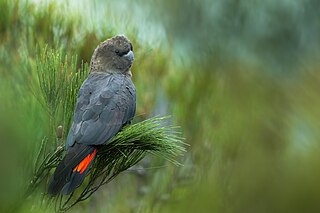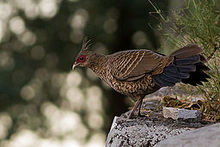
Pheasants are birds of several genera within the family Phasianidae in the order Galliformes. Although they can be found all over the world in introduced populations, the pheasant genera's native range is restricted to Eurasia. The classification "pheasant" is paraphyletic, as birds referred to as pheasants are included within both the subfamilies Phasianinae and Pavoninae, and in many cases are more closely related to smaller phasianids, grouse, and turkey than to other pheasants.

The golden pheasant, also known as the Chinese pheasant, and rainbow pheasant, is a gamebird of the order Galliformes and the family Phasianidae (pheasants). The genus name is from Ancient Greek khrusolophos, "with golden crest", and pictus is Latin for "painted" from pingere, "to paint".

The green pheasant, also known as the Japanese green pheasant, is an omnivorous bird native to the Japanese archipelago, to which it is endemic. Some taxonomic authorities consider it a subspecies of the common pheasant, Phasianus colchicus. It is the national bird of Japan.

The rufous-bellied eagle or rufous-bellied hawk-eagle is a bird of prey in the family Accipitridae that is found in the forested regions of tropical Asia. Relatively small for eagles and contrastingly patterned like a falcon, this species was earlier placed in the genus Hieraaetus and sometimes also in the genus Aquila but thought to be distinctive enough to belong to a separate genus.

The koklass pheasant is a species of gamebird, being closely related to progenitive grouse that lived during the Miocene. They are distantly related to pheasants and are most closely related to grouse and turkeys. Koklass are the only species in the monotypic genus Pucrasia. Both the words koklass and pucrasia have been onomatopœically derived from the bird's territorial call.

The cheer pheasant, also known as Wallich's pheasant or chir pheasant, is a vulnerable species of the pheasant family, Phasianidae. It is the only member in the genus Catreus. The scientific name commemorates Danish botanist Nathaniel Wallich.

The Indian paradise flycatcher is a medium-sized passerine bird native to Asia, where it is widely distributed. As the global population is considered stable, it has been listed as Least Concern on the IUCN Red List since 2004. It is native to the Indian subcontinent, Central Asia and Myanmar.

The crested partridge also known as the crested wood partridge, roul-roul, red-crowned wood partridge, green wood quail or green wood partridge is a gamebird in the pheasant family Phasianidae of the order Galliformes, gallinaceous birds. It is the only member of the genus Rollulus.

The silver pheasant is a species of pheasant found in forests, mainly in mountains, of mainland Southeast Asia and eastern and southern China. It is introduced on Victoria Island in Nahuel Huapi Lake, Neuquén, Argentina and on Vancouver Island, Canada. The male is black and white, while the female is mainly brown. Both sexes have a bare red face and red legs. It is common in aviculture, and overall also remains common in the wild, but some of its subspecies are rare and threatened.

The Himalayan monal, also called Impeyan monal and Impeyan pheasant, is a pheasant native to Himalayan forests and shrublands at elevations of 2,100–4,500 m (6,900–14,800 ft). It is part of the family Phasianidae and is listed as Least Concern on the IUCN Red List. It is the national bird of Nepal, where it is known as the danphe or danfe, and state bird of Uttarakhand, India, where it is known as a monal. The scientific name commemorates Lady Mary Impey, the wife of the British chief justice of Bengal, Sir Elijah Impey.

The glossy black cockatoo, is the smallest member of the subfamily Calyptorhynchinae found in eastern Australia. Adult glossy black cockatoos may reach 50 cm (19.5 in) in length. They are sexually dimorphic. Males are blackish brown, except for their prominent sub-terminal red tail bands; the females are dark brownish with idiosyncratic yellow marking around the neck and prominent sub-terminal tail band of red with black bars. Three subspecies have been recognised, although this has been recently challenged, with a detailed morphological analysis by Saunders and Pickup 2023 finding there is cline in body dimensions over the latitudinal range of the species, with the birds from the north of the range smaller than the birds in the south. Saunders and Pickup argued that with no differentiation in bill morphology, little difference in genetic makeup, no differences in plumage pattern or colour, and no differences in diet, there is no justification in subdividing the species.

The white-crested laughingthrush is a member of the family Leiothrichidae. It is a highly social and vocal bird found in forest and scrub from the Himalayan foothills to Southeast Asia.
The imperial pheasant is a gallopheasant from Southeast Asia. Long thought to be an enigmatic and elusive species, it is actually a cross of Edwards's pheasant and the silver pheasant, a hybrid.

The Bornean crested fireback is a medium-sized forest pheasant from Borneo and the Bangka Belitung Islands. It is the type species of the genus Lophura. Prior to 2023, it was referred to as simply the crested fireback as the Malayan crested fireback was lumped with this species, though both have since been split.

The pheasant coucal is a species of cuckoo in the family Cuculidae. It is found in Australia, Timor and New Guinea. Its natural habitats are subtropical or tropical moist lowland forests and subtropical or tropical mangrove forests. It has adapted well to canefields in northern Australia. The pheasant coucal is unusual among Australian cuckoos in that it incubates and raises its own young instead of laying its eggs in the nest of another species.
Hkakaborazi National Park is a national park in northern Myanmar with an area of 1,472 sq mi (3,810 km2). It was established in 1998. It surrounds Hkakabo Razi, the highest mountain in the country.
Naina Devi Himalayan Bird Conservation Reserve is a wildlife reserve in the Nainital district of the state of Uttarakhand in India. This reserve forest is located in Kumaon region of Uttarakhand and placed inside Nainital forest division. Nainital forest division at present has several birding trails and forest patches consisting of temperate broad-leaf forests to alpine grasslands to rhododendron shrubberies. Wide altitudinal variation supports a very large segment of avian fauna to inhibit in this forest range.

Blyth's paradise flycatcher, also called the oriental paradise flycatcher, is a species of bird in the family Monarchidae. This species occupies evergreen broadleaf forests and forest edges, including secondary growth, gardens, and plantations, typically in lowland and foothill regions. Some populations undertake migratory movements.

The Malayan crested fireback or Malay crested fireback is a species of forest pheasant found in lowland forests of the Thai-Malay Peninsula and Sumatra.



















